These easy crumpets are made without yeast comes together in one bowl and can be ready in 10 minutes. Bouncy, fluffy and light, no yeast crumpets are delicious warm and fresh and stay soft for days.
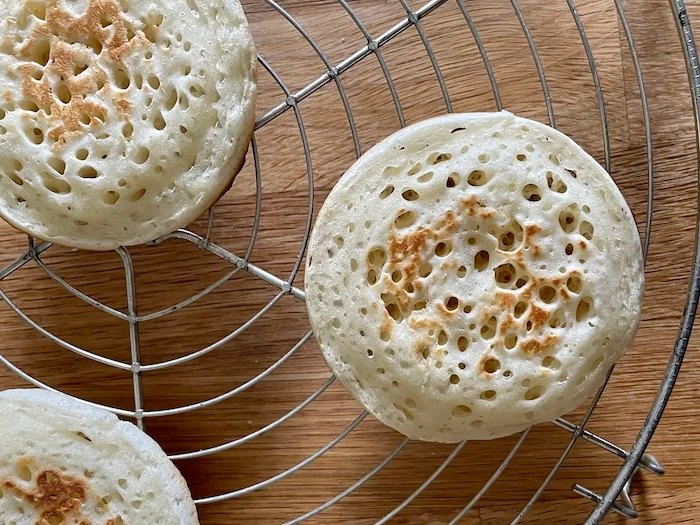
The best and most reliable crumpet recipe does not use yeast, and this blog post will tell you why. (I go through my process for developing this recipe and why it works in the companion video, embedded in the recipe card below).
More breakfast ideas:
Try these Sourdough Montreal-Style Bagels – Vegan and these Bran & Prune Muffins (Vegan).
After many failed crumpet attempts using various recipes – some with sourdough, some with sourdough discard, and some with yeast – I went to Metro in frustration to buy a packet of crumpets. I was eating the crumpet and looking at the ingredients list when there was an “aha” moment. There is no yeast in the ingredients.
I consider this brand of crumpets (Oakrun Bakery) to have the ideal texture as it has a very defined honeycomb with a bouncy texture when toasted. (Aside from no yeast, they also use more sugar than a typical crumpet recipe.)
If a commercial crumpet producer does not use yeast in their recipe, surely there are good reasons for that. Here is the ingredient list which I used as a guideline when developing this final recipe for no yeast crumpets. Of course, leaveners like potassium bicarbonate and monocalcium phosphate are hard to obtain for the home baker. However, we do have access to sodium bicarbonate – that is, baking soda – a trusty chemical leavener that reacts reliably (unlike yeast, a living organism which does not always reliably produce the same amount of CO2 each time).
After adjusting for hydration, I’ve come up with a recipe I am pleased with. Do note that aside from the recipe itself, the other essential element to making good crumpets full of holes is to cook it properly over enough heat. I hope you give it a try and also have consistent holey crumpets.

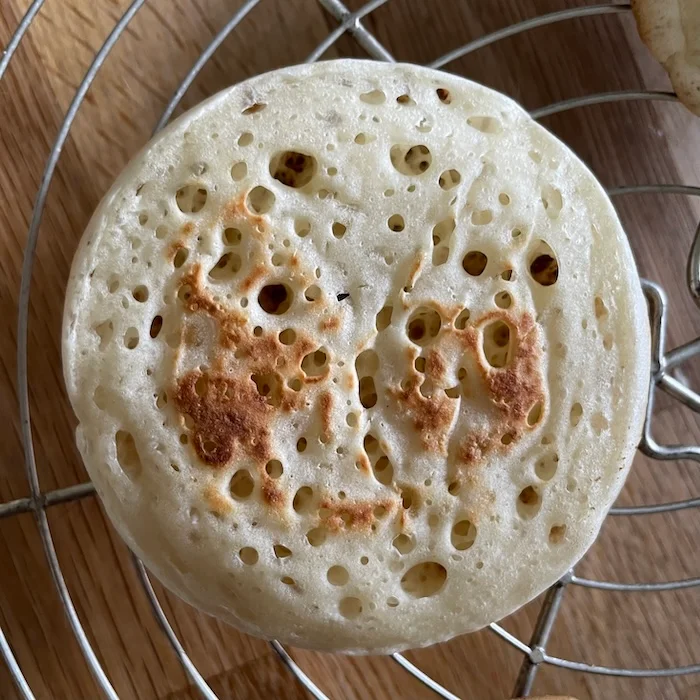
Why this recipe works
- Commercial crumpets sold in supermarkets have no yeast. Not only do we eliminate the yeasty taste, but we also eliminate the potential for under or over proofing. These no yeast crumpets bubble up reliably regardless of the ambient temperature of your kitchen and reduces overall recipe prep time.
- Accurate calculations for vinegar ensure that these no-yeast crumpets have no bitter baking soda taste.
- Baking soda instead of baking powder is used because the different ingredients and composition of different brands of baking powder can affect crumpet texture.
- 130% hydration batter is “just right” for optimally forming crumpet holes. (Note: this may vary depending on your flour)
Why no yeast crumpets are better than yeasted crumpets
Crumpets require lots of aearation, while yeast is effective for doughs, it is an ineffective way of leavening a high hydration batter. Furthermore, most yeasted crumpet recipes out there also use baking powder. The leavening effect of yeast is sub-optimally utilized in these recipes.
Yeast is unreliable. Yeast is a living organism. This means that it is sometimes more active and sometimes less active in producing gas, depending on conditions. It can also die, meaning no rise at all. It is easy to underproof or overproof crumpet batter. Over-proofing batter may result in the yeast eating some of the gluten proteins, leading to suboptimal crumpets.
This no yeast crumpet recipe can be ready in as little as 10 minutes from start to finish. This means that we cut down on 30+ minutes of rising time.
Tips for success – getting the best crumpet holes
Crumpet batter
- Crumpet batter should be beaten well in order to develop the gluten. Inadequate gluten development will result in less bouncy crumpets that are less likely to form holes or honeycomb.
- If you are mixing by hand, whisk vigorously for at least 2 minutes.
- Use flour with a higher protein content like bread flour or all purpose. Do not use cake flour.
- Work quickly after adding the vinegar. The vinegar will activate the baking soda and make the batter bubbly and light. Incorporate the vinegar quickly and thoroughly, and then be gentle with the aerated batter. Pour the batter into crumpet rings immediately after whisking in the vinegar.
Greasing the pan and crumpet rings
- Use a neutral oil with a high smoke point instead of butter to grease the rings and pan.
- Make sure to grease your pan well if it is not nonstick and take care to reapply oil if making batches of crumpets.
Temperature
- Temperature is of the utmost importance when making crumpets. A steady, even heat is required to form those holes and honeycomb texture.
- Measure the temperature of the pan using a thermometer. The temperature of the surface should be around 150 degrees Celsius when the batter first hits the pan.
- The ideal cooking pan for crumpets is made from a material that retains heat well. For instance, an iron or cast-iron pan or griddle will be suitable.
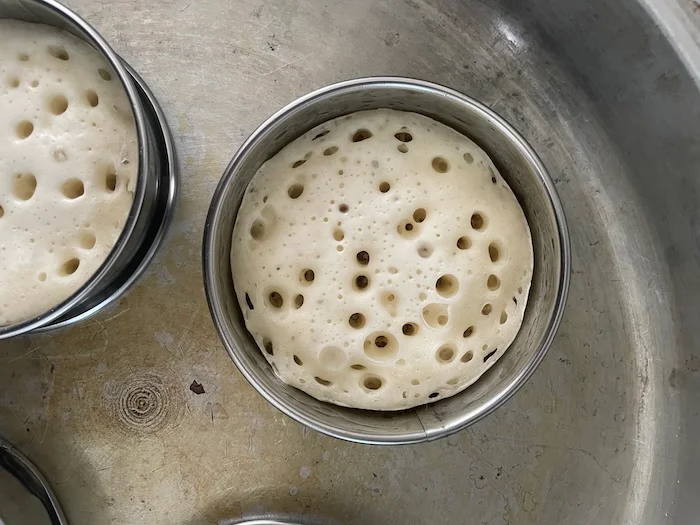
Troubleshooting
Not enough holes or holes close up too quickly
- Check batter consistency. Each type and brand of flour may absorb water slightly differently. If the crumpet batter is too thin, the holes may appear but then quickly close up leaving a flat cooked top. If the batter is too thick, the bubbles may not be strong enough to go all the way to the top and pop by itself. Adjust by increasing or decreasing hydration level.
- Check temperature of pan/cooking utensil. The honeycomb effect requires enough heat from the bottom. If holes are not appearing, it is likely that the pan is not hot enough. Crumpets also require steady, even heating so will work best cooked on a thick and heavy pan or griddle that retains heat well.
Crumpet is cakey or mushy
- Gluten is not developed enough. Try whisking/beating the batter for longer, using an electric beater, or letting the batter sit for 30 minutes or more.
- Check that baking soda is active, and that baking soda instead of baking powder is used.
- Check that crumpet is cooked through and the ingredients are measured correctly. If the crumpet is mushy, the batter could be too wet.
Bottom of the crumpet is too dark
- After bubbles have formed and crumpets develop holes, lower the heat until crumpets are cooked through.
Crumpet sticks to the rings and/or the pan
- If you are not using a nonstick cooking surface, you may need to grease or oil the crumpet rings and/or pan more heavily. Make sure to also regrease if you are cooking in batches.
- Some sticking to the pan is okay. After removing the rings, use a thin spatula to scrape off/remove the crumpets from the pan. The crumpet should come off in one piece.
Baker’s percentage
| Ingredient | Percentage |
|---|---|
| Flour | 100 |
| Water | 101 |
| Baking soda | 2 |
| White vinegar (5% acetic acid) or other neutral tasting vinegar | 29 |
| Sugar | 6 |
| Salt | (Optional) 1 or less |
You must modify the recipe if your vinegar is not 5% acetic acid.
Use the formula below to calculate how much vinegar to use. Once you have this number, multiply it by 2 (the percentage of baking to flour), then subtract the product from the hydration (130) to find out how much water to use.
The amount of acetic acid in a vinegar is listed on its label.
[0.715 g/(acetic acid percent of vinegar) = amount of vinegar to neutralize 1g baking soda]*percentage of baking soda in recipe
Source
Here are some examples:
For 4% acetic acid, use 35.75 g vinegar and 94.25 g water
(0.715/0.04 = 17.9)*2 = 35.75
130-35.75 = 94.25
For 6% acetic acid, use 23.8 g vinegar and 106.2 g water.
(0.715/0.06 = 11.9)*2 = 23.8
130-23.8= 106.2
Homemade crumpets vs storebought crumpets
The biggest pro homemade crumpets have over storebought is that the homemade ones stay soft and bouncy at room temperature. The storebought crumpets only become soft once toasted. This is likely because storebought crumpets have a long shelf life and were made much longer ago than any homemade crumpet.
The storebought crumpets also have a more defined honeycomb texture than my homemade crumpets. Although the homemade crumpets had a comparable amount of holes, the texture inside was more bubbly and loose. Compared to the storebought crumpets’ vertical honeycomb structure, the honeycomb structure in these homemade crumpets were much less defined. I am pretty sure this difference in texture is due to the presence of potassium bicarbonate in the storebought crumpets.
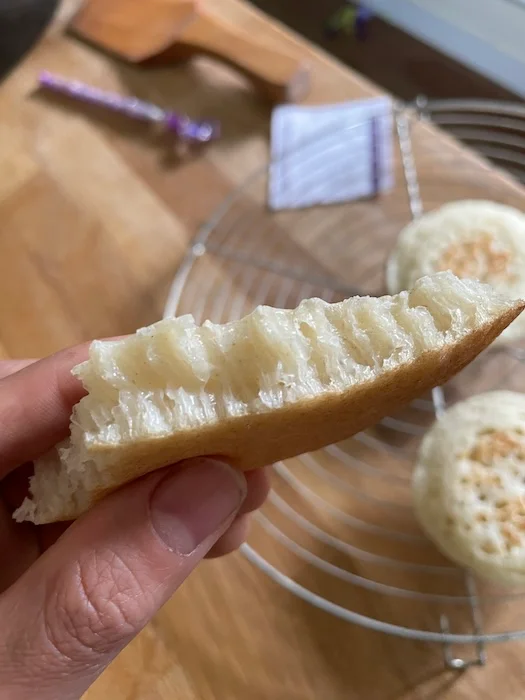
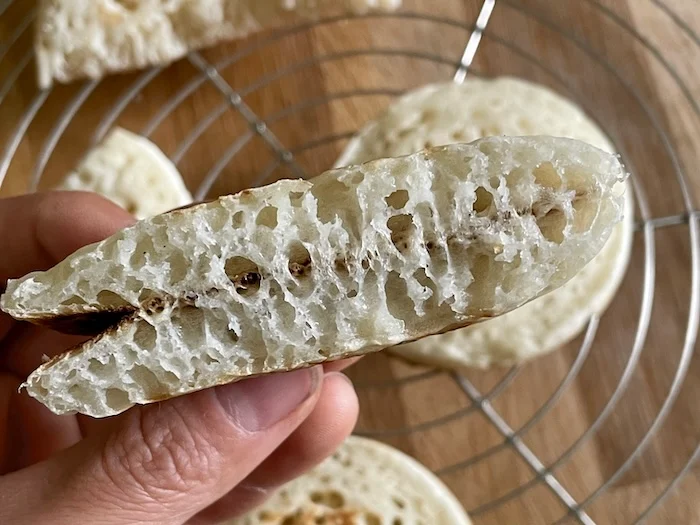

Taking crumpets to the next level with potassium bicarbonate or potassium carbonate
In this scientific article comparing potassium bicarbonate to baking soda, researchers found that potassium bicarbonate altered gluten secondary structure, improved elongational viscosity and dough strength, and caused gluten aggregation.
Although I have not tried this in crumpets yet, you can find in Chinese groceries a product labeled as Potassium Carbonate & Sodium Bicarbonate Solution (碱水 jiǎn shuǐ (trans: lye water). This solution is a crucial ingredient in bai tang gao/bok tong go (white sugar cake), a steamed rice cake full of holes and known for its honeycomb texture.
For a better honeycomb texture, we can therefore add potassium bicarbonate (available online), or we can use a potassium carbonate and sodium bicarbonate solution.
No Yeast Crumpets
Equipment
- Crumpet rings
- Cast iron or iron griddle or pan (optional)
- Thermometer (optional)
Ingredients
- 100 g Flour
- 101 g Water
- 2 g baking soda
- 29 g white vinegar 5% acetic acid
- 6 g white sugar
- Pinch salt
- Neutral oil for brushing
Instructions
- Preheat a heavy duty or iron pan over medium heat. Rub or brush with oil. Prepare crumpet rings by greasing with oil and place on the pan to preheat.
- Whisk together all of the ingredients EXCEPT for the white vinegar. Whisk vigorously for 2-3 minutes until the gluten feels somewhat strengthened.
- By this time, the pan should have preheated for around 5 minutes. If you have a thermometer, measure the temperature of the pan. It should be around 150 degrees C. If it is not at temperature yet, wait until it reaches close to 150 C before proceeding to the next step.
- Pour the vinegar into the batter all at once. Working quickly, whisk to thoroughly combine. The batter will bubble up immediately.
- Pour the batter into the preheated crumpet rings. There should be around 1 cm of batter in each ring, but the batter will rise immediately. The crumpet rings should be 1/3 to ½ filled when the batter is initially poured in. Do not overfill or the batter may overflow. The batter will bubble up and holes will start appearing within a minute.
- The tops of the crumpets should be full of holes. If it is not, see the troubleshooting section above. Lower the heat if the bottoms of the crumpets get too dark. Remove the crumpet rings once the edges of the crumpets are cooked and dry. The rings should be easy to remove. If the rings were adequately greased, the edges of the crumpets should shrink away from the rings as they cook.
- Cook over medium heat until the tops of the crumpets are dry. Lower the heat if the bottoms of the crumpets get too dark.
- Flip the crumpets over and toast the other side lightly (30 seconds) or if desired, for longer until golden.
- Enjoy warm with butter or let cool before putting away. These crumpets will continue to be soft the following day at room temperature and can also be reheated in the toaster if desired.
Video
@hellenshouse No yeast crumpets – The better faster alternative to yeasted crumpets. with no rising time, these crumpets can be made in 10 minutes !! once you try these, you’ll see why these simpler crumpets are so much better than the any crumpet recipe using yeast for the busy home cook 👩🍳 recipe here 🔗 https://hellenshouse.com/no-yeast-crumpets/ #crumpets #crumpet#cookingvideo #cookingtips #recipe #recipedevelopment #teaandcrumpets #bakinghacks #bakingrecipe #quickbread #pancakes #homemadebread #simplerecipes
♬ original sound – Hellen Chan – Hellen Chan
Subscribe to my newsletter
(Sporadic) updates on new posts and recipes sent straight to your inbox.
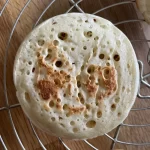
Leave a Reply